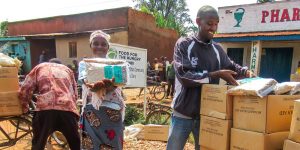Bridging the Hungry Months
Others, Food , HungerContributed by: Fraser Valley Gleaners
The months between planting and harvesting can be precarious, just ask any farmer. Watching and waiting for rain, faithfully weeding, worrying over pests, daily checking the progress of your future pushing gently up from the earth.
And every day, the cupboards grow increasingly bare. In Burundi, these are the lean months, the hungry months. Watching and waiting for the harvest.
Many farming families in Burundi completely run out of food just weeks before they harvest their fields. They are vulnerable to hunger. Their children struggle to stay in school, their empty stomachs driving them to roam their communities looking for a meal instead of heading to class.
In Food for the Hungry (FH) partner communities, these are the families identified by their own leaders as “most vulnerable.” So when it comes time to distribute emergency food aid, they’re placed first in line to receive help.
Other families are able to eek out meals while they wait for their harvest, managing to put something on their children’s plates every day. But that “something” is often food devoid of real nutrients. No vegetables, meat, or legumes. Just starches like sweet potatoes, bananas, and potatoes.
Better than starving, for sure! But healthy? Not really. Eating the same carb-heavy meals over and over means families, especially growing children, are missing out on vital nutrients. They’re not getting the vitamins, minerals, and proteins they need to grow up healthy and strong. They’re in danger of malnutrition.
With seven hungry children to feed, that’s the position Goreth and her husband found themselves in last year. “Before, I and my family used to eat an unbalanced diet,” Goreth explains.
They weren’t used to eating green vegetables and assumed that as long as they could keep their children’s bellies full, that was enough. They didn’t know their children were missing nutrients critical to their development.
With the arrival of the Canadian Gleaners dried vegetable soup mix, that changed. Goreth and her husband learned from FH how mixing the soup with their sweet potatoes or cassava could dramatically boost their children’s health.

This nutrient-dense soup helps kids kick malnutrition and forge a brighter future.
“Our children are no longer missing classes!” Goreth celebrates.
Goreth is a member of a FH Cascade Health Group and also actively participates in a Savings and Loans Group. She’s started applying new agricultural methods she’s learning from watching model farmers in her community work in their demonstration fields.
As Goreth steps up her efforts to work in her fields to meet the needs of her family, she’ll no longer need the soup mix to provide a healthy, balanced diet to her children. She’ll grow her own vegetables to feed her large family, and to sell for income.
“I dream of expanding my cultivating space and becoming a model farmer. I hope to see my children finish their studies and gain a better future.”
Goreth knows all these dreams will only be realized if she perseveres at working toward a sustainable future for her family.
Over 550 families in Goreth’s community of Bugabira received soup mix last year—each family went home with 10 bags! One bag can last the average family for an entire month. This soup sent by generous Canadian donors helped those who were on the edge of starvation make it through the hungry months. And it boosted the health of families like Goreth’s who are just beginning their journey to sustainability—learning, planting, growing, and dreaming toward a brighter future.
Send dried soup mix to more families like Goreth’s to stop malnutrition and bridge the gap of the hungry months.


